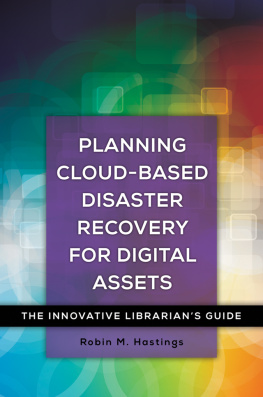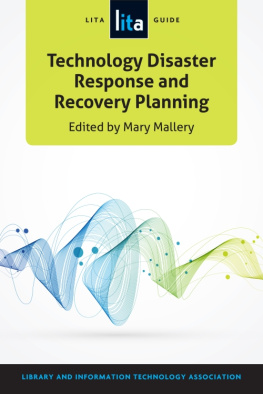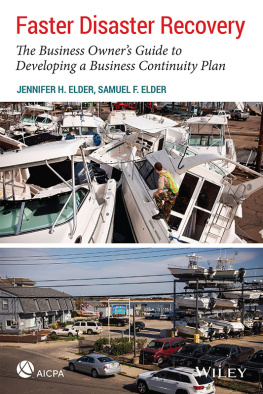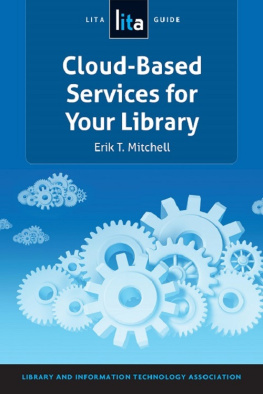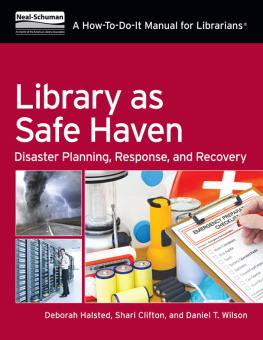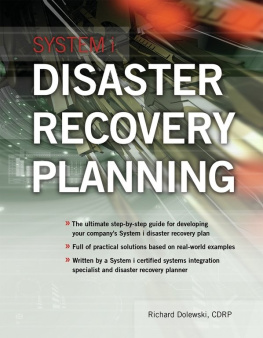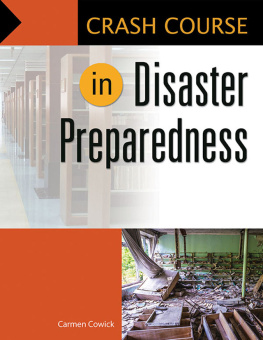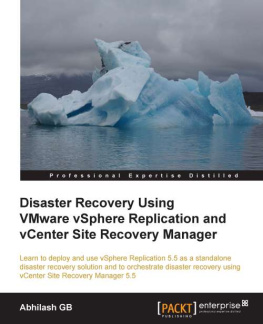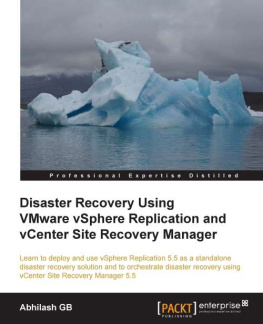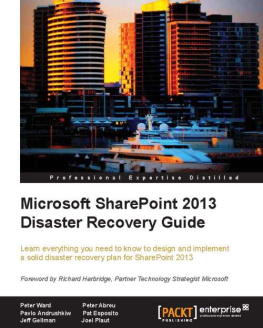PLANNING CLOUD-BASED DISASTER RECOVERY FOR DIGITAL ASSETS
Recent Titles in Libraries Unlimited's Innovative Librarian's Guide Series
Digitizing Audiovisual and Nonprint Materials:
The Innovative Librarians Guide
Scott Piepenburg
Making the Most of Digital Collections through Training and Outreach:
The Innovative Librarians Guide
Nicholas Tanzi
Digitizing Your Communitys History:
The Innovative Librarians Guide
Alex Hoffman
Customizing Vendor Systems for Better User Experiences:
The Innovative Librarians Guide
Matthew Reidsma
Optimizing Discovery Systems to Improve User Experience:
The Innovative Librarians Guide
Bonnie Imler and Michelle Eichelberger
PLANNING CLOUD-BASED DISASTER RECOVERY FOR DIGITAL ASSETS
The Innovative Librarian's Guide
Robin M. Hastings
INNOVATIVE LIBRARIANS GUIDE
Copyright 2018 by Robin M. Hastings
All rights reserved. No part of this publication may be reproduced, stored in a retrieval system, or transmitted, in any form or by any means, electronic, mechanical, photocopying, recording, or otherwise, except for the inclusion of brief quotations in a review, without prior permission in writing from the publisher.
Library of Congress Cataloging in Publication Control Number: 2017041185
ISBN: 978-1-4408-4238-2 (paperback)
978-1-4408-4239-9 (ebook)
22 21 20 19 18 1 2 3 4 5
This book is also available as an eBook.
Libraries Unlimited
An Imprint of ABC-CLIO, LLC
ABC-CLIO, LLC
130 Cremona Drive, P.O. Box 1911
Santa Barbara, California 93116-1911
www.abc-clio.com
This book is printed on acid-free paper 
Manufactured in the United States of America
Contents
As always, any book is a work of a bunch of different people making my work possible. Thanks to the Northeast Kansas Library System (NEKLS) staff for their patience as I took random days off to work on this stuff and for being sounding boards when necessary! Th anks also to my family, including my new husband who got to deal with the crazy of wedding planning while writing a bookthanks for your patience, Mike!
Disaster planning has been necessary for as long as there have been disasters. The amount of information about how to plan, what to plan for, and what to do with the plan once a disaster happens is plentifulalmost too plentiful. What this book will do is to take those long-tested best practices for disaster planning, ones that have been refined by time, and put them in a modern, cloud-based context.
Most disaster plans you find on the Internet today assume that you have all your important documents on paper, so copying and storing multiple copies of your insurance policies and personnel records and financial records is a major step in most disaster planning guides. This is changing, though, and many of us now have our documents stored on file servers or individual computers in our organizations. This makes copying and protecting easierbut only if we do it in a systematic and organized way.
For the purposes of this book, cloud-based technology will be loosely defined as server space or application services that are not based in your organization. The essence of the cloud is that no one should care much about where the information and applications used actually live. Its just out there somewhere. Of course, for truly comprehensive disaster planning, you do want to know where your data and applications are being stored so that you can choose multiple locations across the country for their storage. If a hurricane hits Florida and all your data were in a server farm in Miami, you might have a problem. Multiple data farms in use in multiple areas of the country keep your data safesort of a large-scale LOCKSS (Lots of Copies Keep Stuff Safe) solution. For the most part, though, and for the purposes of this book unless indicated otherwise, cloud-based means not in your building or office space.
Also for the purposes of this book, the definition of digital assets will be pretty much anything that isnt on paper. This can be documents, databases, and applicationsalong with anything else that requires a computer to access or use it. A librarys digital assets can include both administrative assets financial data, insurance papers, documents of any kind, reallyand materials. Saving physical assets (such as the books owned by the library or the actual computers used to access and use the librarys digital assets) is beyond the scope of this book. There are a number of resources for physical preservation of library spaces and assetsin this book, the focus will be on the preservation of the librarys computer and network-based stuff.
Organization of the Book
This book is organized in a linear fashion: after the introductory material in wraps up the information in the previous chapters into a summary of how to deal with the plan after you have created it. Finally, there are appendixes in the back with checklists to use during the planning stages as well as during the evaluating cloud services stages. Th ose will be available on the web for you to print and make use of as well.
How to use the Book
You can dip into and out of the book as needed, certainly. If you have a decent plan in place and just want to be sure that you are protecting your digital assets properly, might be just what you need. If your organization has no real plan in place, however, reading through the book in order will give you a strong grounding for planning, creating, testing, and making your disaster plan useful for when the worst happens.
No matter where you are in the process of planning for disaster at your library, this book will give you concrete guidance for the process itself as well as ideas for how to manage both the process of planning and maintaining that plan using convenient and relatively inexpensive cloud technologies. As the use of the cloud grows in libraries, you will undoubtedly find new uses and features of cloud computing that will assist you in your planning and carrying out of those plans during a disaster. Disaster planning is becoming more and more necessary as the world changes, and having a good, solid, usable plan in place is becoming more of a requirement for every library. Let this book help you protect your materials, facilities, and, most importantly, staff in the event that the worst should happen!
Chapter 1
What Is a Disaster?
Generally, disasters seem to be pretty noticeable. Natural disasters such as tornadoes, hurricanes, earthquakes, and floods are hard to miss. There are other kinds of disasters, though, that those of us in libraries need to consider when putting together a complete disaster plan. For a small library, a hard drive crash or an accidental leaking of patron data can be a pretty big disaster. To properly plan for and manage disasters, we need to consider what constitutes a disaster.
Many disasters are actually pretty small and easy to miss. Someone hacking into your server to use it as a way to serve illegal files (pirated movies, software, etc.) can go unnoticed until the government notices and comes in to take your serveras well as all the data, software, and everything else stored on that machineas evidence in a crime. If you dont have a plan to deal with the loss of that serverfor whatever reasonyou have a disaster on your hands from which you might find it hard to recover.

